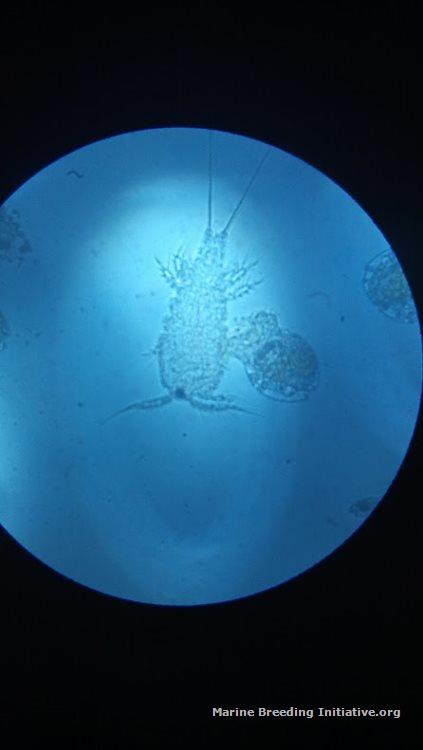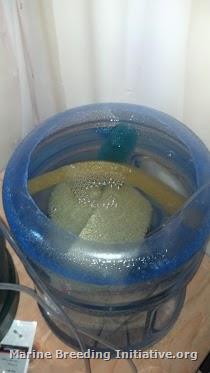Reports tied to this Journal
Author
|
Message

|
 Culture Journal, Species: Tisbe biminiensis
Friday, April 12, 2013 1:13 PM
Culture Journal, Species: Tisbe biminiensis
Friday, April 12, 2013 1:13 PM
( permalink)
Culturing Journal DataSheet
This first post should be updated regularly to include new information as events take place or changes are made to your system General Species: Tisbe biminiensis Species description: Small harpacticoid copepod Culture source (link if possible ): LiveAquaria - http://www.liveaquaria.com/product/prod_display.cfm?c=747+3137+3058&pcatid=3058&siteid=20&&topcatid=2190 If algae, CCMP # (Optional ): http://ccmp.bigelow.edu/ Culture Establishment Date: 3/4/2013 Continuation Date: Culturing Vessel Details Salinity: 1.022 Temperature: Room temp, 68-70F pH:
Vessel description: 5 gallon inverted carboy Lighting description: Ambient Lighting cycle: Aeration description: Medium to Light, not enough to cause a "boil" Methodologies Split methodology: No scheduled splits. Population reduction happens when I harvest (as needed) and when I attempt to clean detritus from the bottom of the culture. When harvesting I run the culture water though a 53um sieve. I replace this water with fresh (aged) ASW (Instant ocean). Culture medium description: 150ml of mixed homegrown phyto (nanno and iso, 1/2 part of each) every two to three days. I also add ammonia locking additives every once in a while. Cell count: (if known) Reference links: Additional Information (No Pictures or Videos in the Section Please) Notes: One thing that I am trying with my tisbe culture is to use sponges (most often filter replacement sponges) to try to get culture densities higher. Since these are harpacticoid, I would assume that a 5 gallon carboy wouldn't be the best culture vessel for these. That is the problem that I hope the sponges help correct. I'm hoping that they will colonize in the sponges as well as the sides/bottom of the carboy. I also hope to use these sponges for harvesting. If colonized, I should be able to lift a sponge out, place a sieve under, and collect a good number of tisbe. You will be required to provide photographic evidence and as much detail as possible about your project in this thread.
If your thread does not contain detailed enough photos and information the MBI Council will not be able to approve your reports.
<message edited by nrbelk on Friday, April 12, 2013 11:56 PM>
|
|
|
 Re:Culture Journal, Species: [Insert Species Name Here]
Friday, April 12, 2013 1:14 PM
Re:Culture Journal, Species: [Insert Species Name Here]
Friday, April 12, 2013 1:14 PM
( permalink)
Pictures coming soon, that said, how's the standard way to take pictures of these tiny guys?
|
|
|
 Re:Culture Journal, Species: [Insert Species Name Here]
Friday, April 12, 2013 11:58 PM
Re:Culture Journal, Species: [Insert Species Name Here]
Friday, April 12, 2013 11:58 PM
( permalink)
Picture of them. It was hard to get using a microscope and slide with a slide cover. Interesting fact though, it seems that the adhesiveness of the slide against the slide cover, when there is water between, is enough to kill the copepod. I also found out that my culture is contaminated with rotifers  
|
|
|
 Re:Culture Journal, Species: [Insert Species Name Here]
Saturday, April 13, 2013 1:22 AM
Re:Culture Journal, Species: [Insert Species Name Here]
Saturday, April 13, 2013 1:22 AM
( permalink)
Yes, a slide cover usually squashes them (that's the technical term for it  ). You can see the squashed out guts to the right of the copepod in your image. I have learned that I need to NOT use a slide cover. If possible, use a well slide, or else simply use a drop on a slide without a cover. To make them hold still, use some alcohol or magnesium chloride (google "magnesium chloride anesthetize copepods"). The magnesium chloride makes them look more life like, whereas the alcohol usually makes them collapse their antennules, and otherwise deforms them.
|
|
|
 Re:Culture Journal, Species: [Insert Species Name Here]
Saturday, April 13, 2013 2:50 AM
Re:Culture Journal, Species: [Insert Species Name Here]
Saturday, April 13, 2013 2:50 AM
( permalink)
Thanks for the info.
I see a rotifer to the right of the copepod, but no guts?
|
|
|
 Re:Culture Journal, Species: [Insert Species Name Here]
Saturday, April 13, 2013 2:56 AM
Re:Culture Journal, Species: [Insert Species Name Here]
Saturday, April 13, 2013 2:56 AM
( permalink)
I certainly could be misinterpreting what I am seeing. I have seen very similar images that I've taken where I'm sure I saw the innards of the copepod were squirted out the side due to being crushed by the cover slip, and that is what I though I was seeing here. I could be wrong about this. Now that you mention it, I do see a rotifer right next to a copepod in your image.
I've been wrong before. This probably won't be the last time. Still, everything else I said earlier applies.
|
|
|
 Re:Culture Journal, Species: [Insert Species Name Here]
Saturday, April 13, 2013 2:23 PM
Re:Culture Journal, Species: [Insert Species Name Here]
Saturday, April 13, 2013 2:23 PM
( permalink)
A person told me that it would be a lot easier to find and look at copepods using a disecting microscope, is that true?
|
|
|
 Re:Culture Journal, Species: [Insert Species Name Here]
Thursday, April 18, 2013 3:14 PM
Re:Culture Journal, Species: [Insert Species Name Here]
Thursday, April 18, 2013 3:14 PM
( permalink)
Here is a pic of what I meant with the sponges. It has also proven much easier to harvest by squeezing the sponges out over a sieve rather than pouring from the bottom. 
|
|
|
 Re:Culture Journal, Species: [Insert Species Name Here]
Monday, September 2, 2013 7:52 PM
Re:Culture Journal, Species: [Insert Species Name Here]
Monday, September 2, 2013 7:52 PM
( permalink)
If your culture has decent light, you could put in some macroalgae in place of the sponges. Harps like to drop to the bottom during the day to avoid fish and feathery algaes give them a lot of surface area to hide on and eat bacteria. If this is the case, how are you feeding them to larvae, does bimiensis have a free swimming stage? Some harps do.
Also, I'm not familiar with bimiensis, but some harps actually burrow into the substrate, so sponges would be a better solution than a much buildup on the bottom. Finally, I assume that you will be using this copepod as a first food for larvae? The two long spikes on the tail of bimiensis would make it a challenge for small larvae to eat, the copepod uses the tail spikes to stab the larval mouth and get spit out.
Hope I've helped and not added to the confusion.
|
|
|
 Re:Culture Journal, Species: [Insert Species Name Here]
Tuesday, September 3, 2013 11:20 AM
Re:Culture Journal, Species: [Insert Species Name Here]
Tuesday, September 3, 2013 11:20 AM
( permalink)
Thanks for your input.
I mainly use these copepods to restock refugiums for fish like dragonets and the such. It works pretty well so far.
|
|
|
|